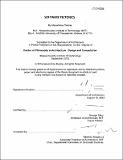Software tectonics
Author(s)
Tsamis, Alexandros, 1976-
DownloadFull printable version (44.56Mb)
Other Contributors
Massachusetts Institute of Technology. Dept. of Architecture.
Advisor
George Stiny.
Terms of use
Metadata
Show full item recordAbstract
The resent shift of attention in the architectural discourse towards issues of ecological design, coupled with the undeniable role of computation, has already cast a new operative role to the notion of environment. Instead of being the passive, conceptualized or historicized context of an architectural object, environment is quite literally becoming the object of design itself. We are moving away from the imposed-preconceived Cartesian object which negotiates through its boundaries its presence within its immediate context. The discipline is already considering an architecture in which architectural form is only an instance of a designed environment. In many respects, this new understanding of environment aspires to be actively designed as a closed system of constant transformation, an autonomous milieu of exchange at all scales and all levels between substances, properties or qualities. The object of investigation in Software Tectonics is how technologies of design and construction allow newly forming propositions about the role of environment in the discipline to become operational tactics in the design practice. SOFTWARE TECTONICS proposes 3 design research projects. VSpace is a computer drawing application for designers. Unlike traditional CAD systems that work primarily by representing boundaries (B-reps), VSpace derives form by the representation and direct manipulation of properties (P-reps) in space. Boundaries and Properties here are considered simultaneously in the same design environment. Castit is a multi axis, Computer Numerically Controlled device that prints 3D objects by dynamically mixing at least two distinct but chemically compatible materials. Dynamic mixing allows for gradient transitions between two or more materials, resulting in objects with anisotropic material properties. CHUNK aims to eliminate a joint as a third mediating member between two building elements with an area of gradient transition. Conceived as a "dynamic insulation" architectural skin, this building technology project challenges the multi-trade and multi-component tectonics of dominant late-industrial building manufacture.
Description
Thesis (Ph. D. in Design and Computation)--Massachusetts Institute of Technology, Dept. of Architecture, 2012. Cataloged from PDF version of thesis. Includes bibliographical references (p. 365-370).
Date issued
2012Department
Massachusetts Institute of Technology. Department of ArchitecturePublisher
Massachusetts Institute of Technology
Keywords
Architecture.